Remember when Netflix used to mail DVDs?
In the late 1990s, Netflix pitched itself as an online video store, a way to rent DVDs without going to a video store
The company was founded in 1997, and launched in 1998 with 30 employees and 925 DVD titles
Using this pitch deck, they raised $30 million in 1999 from Institutional Venture Partners and Tech Crossover. The pitch focused on selection, convenience, and the absence of late fees.
We’re reviewing this deck because it was successful and demonstrated how a simple idea, when pitched clearly, can raise real money.
Let’s take a look at the actual slides of Netflix‘s pitch deck
About Netflix (then vs. now)
Back in 1998, Netflix was an early bet on DVDs—at a time when barely 1% of U.S. households even owned a player.
Co-founders Reed Hastings and Marc Randolph launched the site with 925 titles and a simple idea: rent movies online, get them by mail, and skip the late fees.
The model was straightforward: $4 per rental, $2 shipping. What made them different was their promise to stock every DVD available.
That pitch helped raise their first major round, with Hastings also putting in $2.5 million of his own. Their initial goal? Just crack the top 10 in video rentals.
Today, Netflix is a global entertainment leader with 300+ million paid subscribers in 190+ countries. In 2024, it pulled in $39 billion in revenue and neared a $500 billion market cap.
From mailing discs to producing global hits, the leap is massive.
This pitch marked the beginning and showed how a simple idea can lead to a category-defining company.
Slides in the deck
Detailed Netflix pitch deck analysis (slide-by-slide)
Here’s a complete breakdown of the Netflix pitch deck—slide by slide. I’ll keep it simple and clear: What each slide covers, what works well, what could be better, and takeaways you can apply to your own pitch.
Let’s take a look.
1) Cover Page
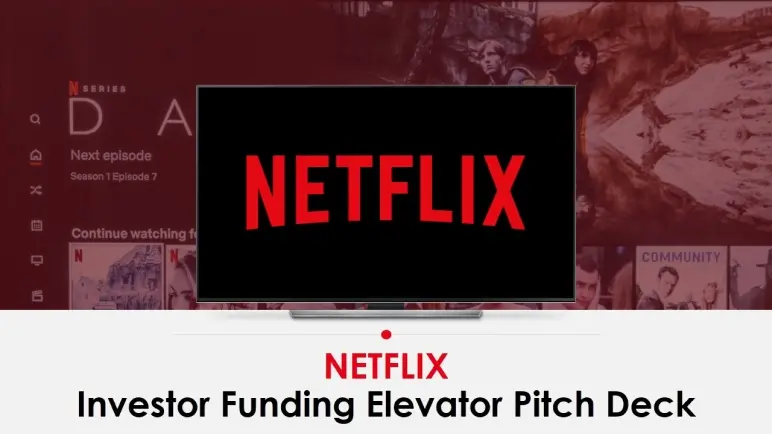
This cover shows the Netflix logo on a TV screen, set against a background of movie thumbnails. It’s bold and attention-grabbing. The title below says it’s an investor pitch deck, which keeps things focused.
I think the design looks good and clearly signals it’s about entertainment. But since Netflix wasn’t a household name back then, a short line like “DVD Rentals by Mail” might’ve helped explain what the company actually did.
Takeaway: When your brand is still new, adding a clear tagline helps people get what you’re pitching—fast.
2) The Problem
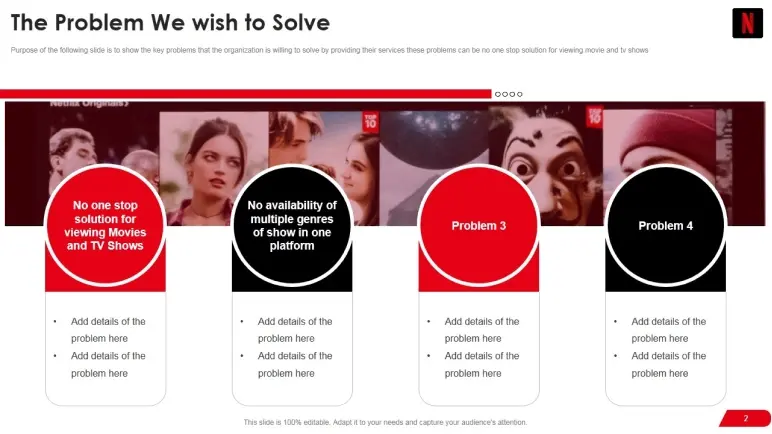
These slides show why watching movies was outdated in 1999
No single place to find both shows and films, limited genres, and too much hopping between rental stores. You either settled for what was left or gave up.
Two of the four problem blocks are placeholders, but the message is clear—viewers wanted more choice, less hassle, and an easier way to watch what they liked.
Takeaway: Calling out real problems people faced—clunky access, missing options—sets up a strong reason for your product to exist.
3) Netflix Solution
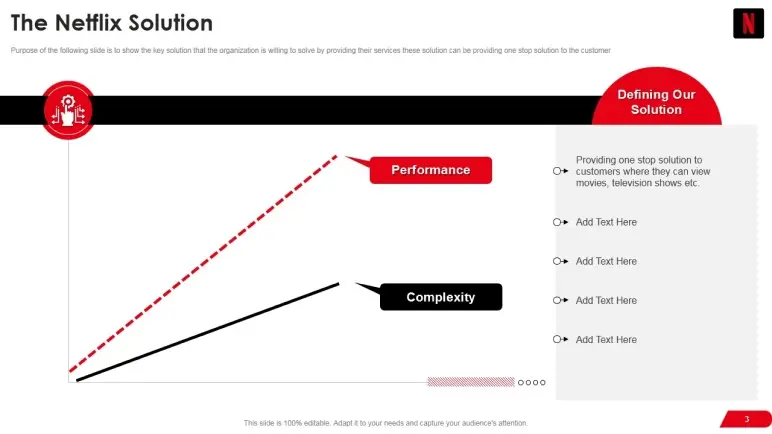
This slide explains Netflix’s core solution. It uses a simple performance vs. complexity graph to show the value: Better results without extra hassle.
On the right, the message is clear—Netflix wants to be the one-stop place for movies and TV shows.
I think this slide works because it keeps things straightforward. The chart gives a quick visual cue that their service is meant to simplify the experience while delivering more value. It avoids too much text and sticks to the main point.
Takeaway: A clear visual and one-liner can go a long way in showing how your product makes life easier.
4) What is Netflix for?
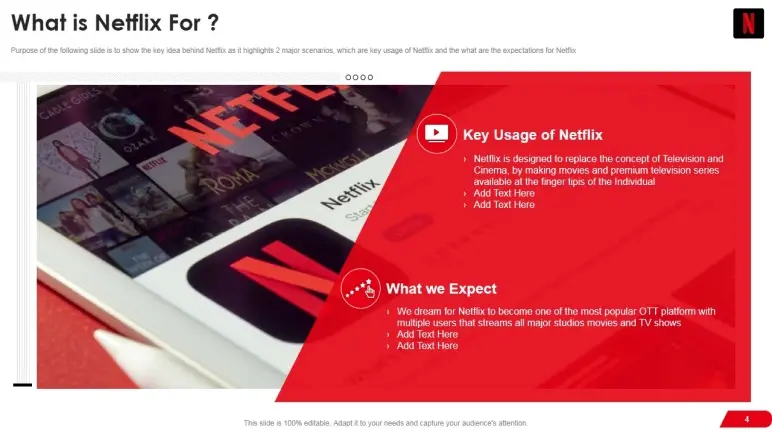
This slide shows what Netflix is actually for. It wasn’t just about using new tech—it was about changing how people watch movies and shows. No more fixed schedules, ads, or trips to the video store.
It also explains the bigger aim: To grow into a leading streaming platform with the kind of content people really want to see—popular films and high-quality series.
Takeaway: A good usage slide should make it clear how your product fits into everyday life, and what future you’re building toward.
Ditch your old-school pitch deck creation methods
Make compelling pitch decks in minutes with AI
Plans starting from $14/month

5) Our Brand Identity
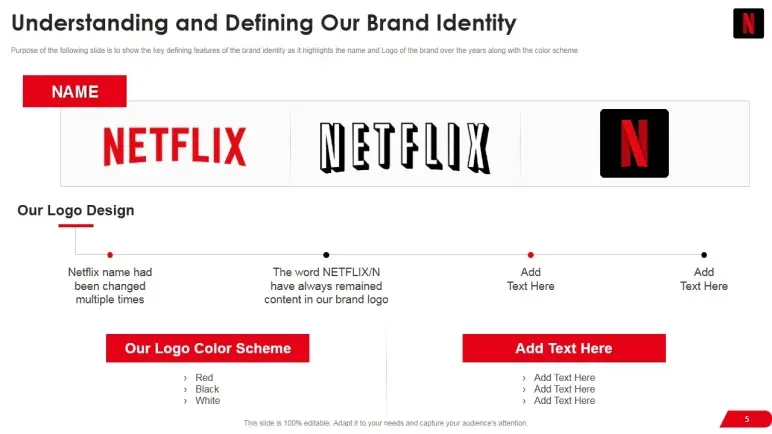
In this slide, Netflix shows how its brand identity has evolved. While the logo design changed slightly over time, the bold red wordmark remained consistent, making it easy to recognize.
The slide also highlights their core colors: red, black, and white. These are used across all platforms—from the app to the website to marketing—creating a uniform and familiar look.
Takeaway: A consistent name, logo, and color scheme builds recognition and keeps your brand easy to remember.
6) Mission Statement
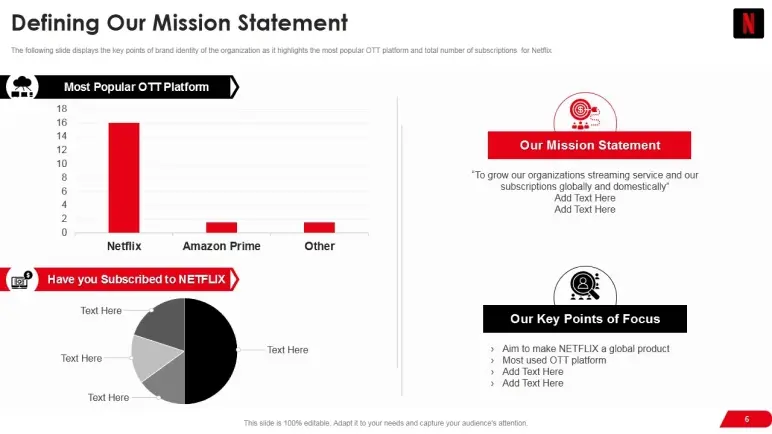
This one outlines Netflix’s mission and big-picture goals. The chart shows they’re already leading in the OTT space, with way more users than competitors.
That adds credibility to their aim of going global and becoming the most-used platform.
I think the mission statement is fine, but it still sounds a bit broad. Phrases like “grow our subscriptions” are expected, but I’d like to see how. Maybe call out real steps, like expanding to new countries or locking in content deals.
Takeaway: Don’t just state your goals, explain what actions will actually get you there. Stats help, but real plans make it stronger.
Ditch your old-school pitch deck creation methods
Make compelling pitch decks in minutes with AI
Plans starting from $14/month

7) Revenue Model

This slide shows how Netflix makes revenue. The business runs on monthly subscriptions with three plans: Basic, Gold, and Premium. Each one costs more depending on what you get.
The chart on the left shows that revenue keeps growing every year. It’s clear the model works, and more people are signing up.
I think, to make the slide stronger, Netflix could have briefly shown what’s included in each plan. That extra context would help viewers understand the value difference behind each price point.
Takeaway: A good revenue model is easy to understand and shows real growth.
8) Customers
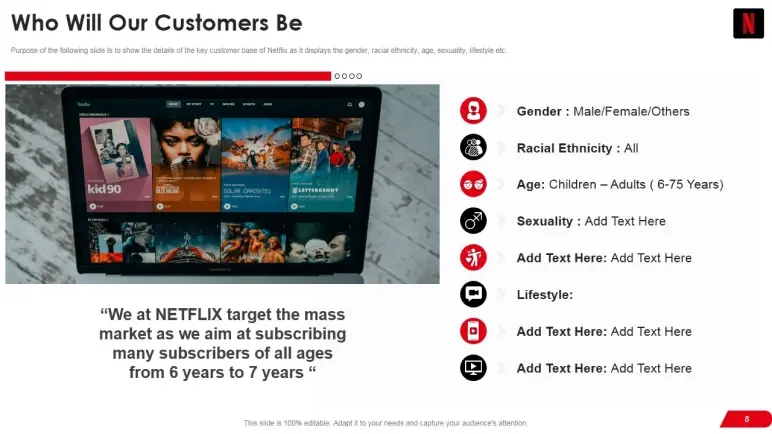
Netflix introduces its ideal customers in this slide. They’re going for a wide audience—people of all ages, backgrounds, and interests. Basically, anyone who watches movies at home.
It’s clear they want to make Netflix feel accessible to everyone. But it would’ve been more helpful if they gave some idea of which groups they’d focus on first, like frequent renters or early tech adopters.
Takeaway: Reaching “everyone” sounds good, but investors want to know who’s most likely to use your product first. Be clear about that.
Ditch your old-school pitch deck creation methods
Make compelling pitch decks in minutes with AI
Plans starting from $14/month

9) Competition
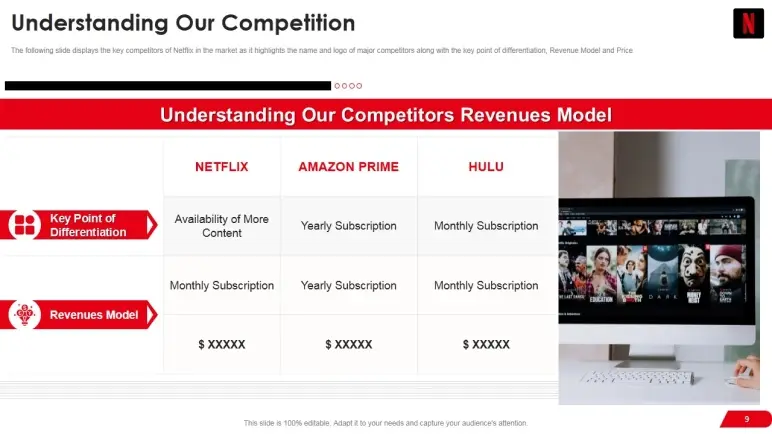
The ninth slide focuses on competition. It compares Netflix with Amazon Prime and Hulu to show differences in pricing and content access.
The key point? Netflix highlights that it offers more content and works on a monthly model, unlike Amazon’s yearly approach.
Hulu is also monthly, but Netflix is trying to stand out by saying it gives more variety.
Takeaway: When showing competition, don’t just list names—make sure you point out what sets you apart in simple terms that investors will remember.
10) Schedule Plan
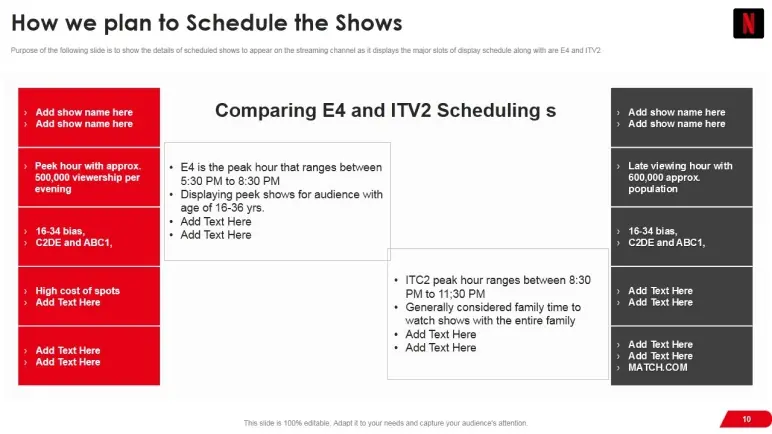
The final Netflix slide shows how they plan to schedule shows. It looks at the most-watched time slots on UK channels like E4 and ITV2 to help decide when to show content.
Netflix points out that 5:30 PM to 11:30 PM is the best time to stream. Younger people (ages 16–34) usually watch earlier in the evening, while families watch later.
This tells us Netflix is planning around real viewing habits so they can show the right content at the right time.
Takeaway: Scheduling content at the right time helps reach the right audience when they’re most likely to watch.
What did I like the most about this deck?
What stood out wasn’t bold claims or flashy design—it was how simply and confidently Netflix explained their idea.
Here’s what I noticed:
- Netflix’s slides were plain. No fancy layouts, no visuals. But that worked in their favor. It kept the focus on the idea.
- Instead of jumping into big numbers or market projections, they focused on a clear pain point: renting movies was a hassle. That made the pitch easy to relate to.
- The deck explained what wasn’t working in video rental and how Netflix offered something better. No jargon, just a clear before-and-after.
- There were no extra slides or filler. Every slide had a clear purpose, whether it was about the problem, their customers, or how they’d grow.
- The tone was steady, focused, and practical. You could tell they had thought things through.
In the end, they weren’t trying to impress—they were just solving a real problem. And that’s what made it work.
Perfect your deck and pitch using Upmetrics
After reviewing Netflix’s pitch deck, one thing is clear—your slides don’t need to be complex. A clear problem, simple visuals, strong structure, and proof of traction go a long way. That’s exactly how Netflix made its case.
Working on your own pitch deck? Upmetrics can help. Use our AI pitch deck creator to build a clean, investor-ready deck without overthinking the design.
Want expert input? Choose our pitch deck design services. and get the support you need to fine-tune your deck—clearer slides, stronger story, and a pitch you’ll feel ready to share.

